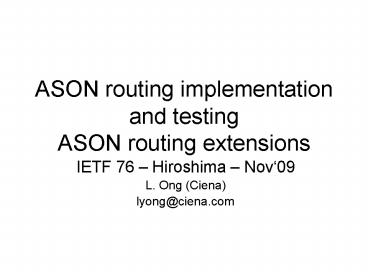ASON routing implementation and testing ASON routing extensions - PowerPoint PPT Presentation
1 / 11
Title:
ASON routing implementation and testing ASON routing extensions
Description:
Draft on ASON Routing Testing Experience. CCAMP work on ASON Routing ... local address prefixes ... NSAP format Local Node Prefix. In addition to IPv4 ... – PowerPoint PPT presentation
Number of Views:64
Avg rating:3.0/5.0
Title: ASON routing implementation and testing ASON routing extensions
1
ASON routing implementation and testing ASON
routing extensions
- IETF 76 Hiroshima Nov09
- L. Ong (Ciena)
- lyong_at_ciena.com
2
Draft on ASON Routing Testing Experience
- CCAMP work on ASON Routing is Experimental
- No standard codepoints have been allocated
- OIF has experimented with similar extensions
- Transport-only instance of OSPF (no IP routing)
- Advertising reachable local address prefixes
- Advertising local/remote TE router IDs for
scoping of routing information (Li/Pi mapping) - Details in draft-ong-gmpls-ason-routing-exper-00.t
xt - OIF would like to see this work on Standards
Track - Contribution provides input on testing of similar
extensions - Tested at interops since 2003, most recently 2007
2009 - At least 7 independent implementations each time
- OIF extensions are offered for CCAMP use
- Can these extensions be adopted directly?
Running code - Will experience help to move work to Standards
Track?
3
OIF Bandwidth advertisement extension
- OIF ISCD extension
- Combines advertisement of bandwidth for multiple
signal types in one ISCD - Advertises separate availability per signal type
- Why
- Standard signal types are placed along specific
boundaries - Availability for new connections at STS-3c/VC-4
or STS-12c/VC-4-4 depends on position of occupied
timeslots - Cannot be determined from total unreserved bytes
per second - Combination is more efficient than separate ISCD
or LSA per signal type - Most link attributes are common across signal
types, combining reduces duplication - Although these are layers in ITU-T sense, they
share the same switching matrix
4
Draft on Extended Routing Functions
- Follow up on previous liaison providing requested
detail - Layer-scoped Link Attributes
- Layer VC-3, VC-4
- Connections available at a particular layer
- Attributes (e.g., metric) that differ for a layer
- Local Connection Type
- CP or TCP (switch or terminate)
- Within layer, not multilayer/adaptation-related
- Looking for better solution than ISCD/IACD
- NSAP format Local Node Prefix
- In addition to IPv4 and IPv6 formats
- New draft submitted with more detail
- draft-theillaud-gmpls-ason-routing-add-fcts-01.txt
5
Layer-scoped link attributes
- G.7715.1 specifies a set of link characteristics
specific to a particular layer network - Most of these attributes would be common across
layer networks supported by a particular link - However, OIF members believe that some attributes
may take different values for different TDM
layers, esp - Link available bandwidth
- TE metric
- Possibly others such as administrative group
- Therefore, the ability to support advertisement
of common attributes on a per link basis but also
to allow some attributes to be scoped to a layer
would be highly useful
6
Layer-scoped link attributes potential solutions
- Advertising multiple TE LSAs for a given link,
the LSA itself scoping the attributes - Is this allowed by GMPLS protocol?
- Is this an efficient mechanism?
- New sub-TLV allowing to scope some attributes to
a specific layer - Proposed in the draft, see draft for details
7
Link associated local connection type
- Section 4.1 in draft-ietf-ccamp-gmpls-ason-routing
-ospf-09.txt proposes to rely on the ISCD(s)
advertised by each link endpoints, to infer the
link local connection type - Inferring the local connection type from ISCDs is
not sufficient - See example
- An explicit local connection type parameter is
desirable - detailed proposed extension contained in the draft
8
Backup
9
Link Characteristics
10
Link associated local connection type
Node1
Node2
- Switching functions
- HO VC-4
- HO VC-3
- Switching functions
- LO VC-3
- For this link, both nodes would advertise the
same ISCD for the VC-3 layer. Node 1 would in
addition advertise an ICSD for the VC-4 layer. - A path computation entity would believe that a HO
VC-3 connection can be set up across this link,
while it cannot - Node2 terminates both HO VC-4 and HO VC-3
layers - Node2 can switch a LO VC-3 layer (from a
terminated HO VC-4 signal)
11
Thanks to contributors
- Richard Graveman (Department of Defense)
- Hans-Martin Foisel (Deutsche Telekom)
- Thierry Marcot (France Telecom)
- Evelyne Roch (Nortel Networks)
- Jonathan Sadler (Tellabs)
- Yoshiaki Sone (NTT Corporation)
- Takehiro Tsuritani (KDDI RD Laboratories)
- Xihua Fu (ZTE)































